
Transformation Weight Control
www.transformationweightcontrol.com
A Brief History of Psychological Treatment Therapies for Weight Loss and Preventing Regain
I. PSYCHOANALYSIS
In the early part of the 20th century the Freudians (that’s Sigmund in the image below) made an effort of solving the challenges of weight loss and preventing regain). It turned out that insight alone was not enough to elicit the behavior changes necessary to control weight. There’s nothing wrong with insight, it’s just that on its own it’s not enough to adequately and effectively lead to behavior changes that will meet the needs of individuals making every effort to control body weight.
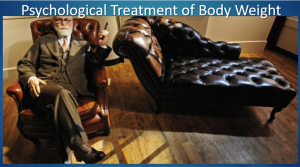
II. BEHAVIOR MODIFICATION
Then along came the behavior modification specialists. Behavior modification certainly works to help change behavior, however, there’s a problem when it comes to managing calorie intake in a toxic food environment. I mean, really, there is food everywhere! For heaven’s sake, what is Godiva chocolate doing at the Barnes and Noble checkout line??? Of course, it’s a rhetorical question, we know why it’s there. But imagine this. Consider that food is addictive for many people (in our program we firmly believe this and have the evidence to prove it). Now, imagine if you had alcohol or cocaine addiction, and everywhere you see food during the day you see bottles of booze or lines of cocaine? How are you possibly going to not get worn down by the sight of the substance of abuse everywhere you go? And consider this; of all five of the senses, sight of food, or any substance of abuse, is always the strongest cure for a trigger. In fact, just seeing food in your mind’s eye, and not even the real thing right in front of you, will trigger a craving. 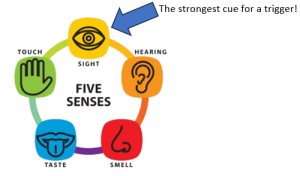
Now, imagine that every day when you walk or drive home from work you pass your favorite pizza place. Maybe you even smell it. Of course, this activating event, just like Pavlov’s dog salivating about food when the bell rings, you too start salivating at the thought of pizza. Think of the sight of your favorite trigger food as your Pavlovian bell! And considering that sight is the strongest of the five senses (hearing, smell, taste, touch, and sight), the event hijacks the neurobiology of your brain, and the pleasure neurotransmitters such as dopamine, irresistibly light up and excite the pleasure and reward centers of your brain. And suddenly the pizza is all you can think about. This is why we think, and why we teach it in our program, that cravings, and your troubles controlling body weight, are NOT your fault. Instead, there is powerful biology at work here!
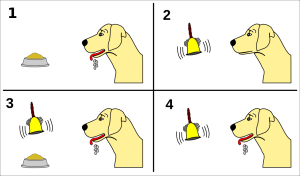
To avoid the pizza trigger, the behavior modification specialists would have you avoid the route home from work that takes you right in front of the pizza place, and since sight is the strongest cue for a trigger, then “out of sight, out of mind”, makes sense. But here’s a problem with behavior modification. There’s a good chance that if you take a different route home, you may pass by another pizza place! See the image of Pizza Place #1 and Pizza Place #2 below.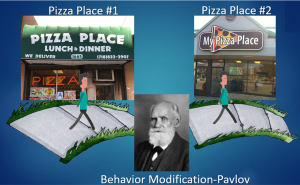
And then the trigger, the activating event, the sight of pizza, lights up your brain. The caption of the Fatty Food image below reads, “No kidding, this is really what happens! You’re not imagining it!” We mean it! Remember, you’re living in a toxic food environment, food is everywhere! The pleasure centers in your brain, and dopamine, are on overdrive! Oscar Wilde said it best, “I can resist anything except temptation.”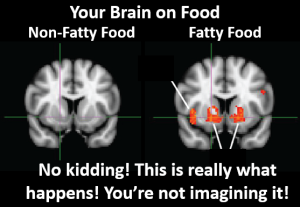
In fairness to the behavior modification therapists, behavior modification has strong and effective methods of therapy and behavior change, it’s just that it’s not always enough to solve the deeper psychological and physiological disturbances necessary for successful and sustainable weight loss and preventing regain. That’s why we use more than behavior modification strategies in our program.
III. COGNITIVE BEHAVIOR THERAPY
And so, in the 1950’s, the cognitive therapists arrived on the scene, taking a deeper look, beyond the insights of psychotherapy, and the relatively simple behavior modification techniques used by behavior modification specialists.
And thus, the psychological treatment of weight loss, and preventing regain, turned to cognitive therapies, with the psychologists Aaron Beck (Cognitive Behavior Therapy) and Albert Ellis (Rational Emotive Behavior Therapy) leading the charge.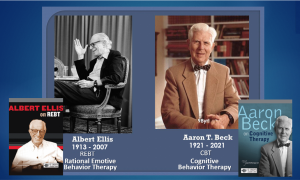
REBT AND CBT EXPLAINED
REBT and CBT are very similar, the differences have more to do with semantics, the theories are virtually the same. The picture below illustrates the model of the ABC’s of CBT, Part 1 of the full CBT model.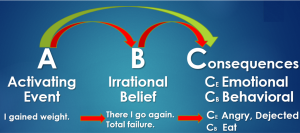
Here’s how it works:
- You encounter or experience an activating event.
- You think about, or have a belief related to the event. Sometimes the belief is rational, but REBT and CBT state that the belief is frequently irrational.
- And then you are faced with two consequences, emotional and behavioral.
The fundamental part of the REBT and CBT is that activating events drive you to irrational beliefs which then drive you to emotional and behavioral consequences, as illustrated above. Those consequences are inconsistent with your goals, what we refer to as “maladaptive consequences”.
Now, if you study the illustration closely, you’ll see a green arrow pointing from the activating event, passing over the beliefs, and landing on the consequences. This is what happens to many people. You experience the activating event, you do have the irrational belief, it’s in your head and in your thoughts, but you skip right over it, it’s unconscious, and you land right on the consequences. And as it turns out, those emotional and behavioral consequences can be so distressing, that they become a new activating event, and then the cycle starts all over, and before you know it, you’re stuck in a cycle of obsessing about food, and filling the need by eating. We refer to this cycle of events as a “secondary disturbance”. And the disturbance can continue. Have you ever stepped on the scale, it set you off for days, then weeks, months, and in some cases, even years, until one day you wake up, you’re 30 pounds heavier, and you think, “what happened?”
So, that’s the story. It’s what we call the paradigm of the ABCs, paradigm in this case, meaning a typical example or pattern of activating events that lead to thoughts or beliefs that lead to feelings with emotional and behavioral consequences. In a word, the paradigm is the model.
As an aside, Dr. Ellis identified four core irrational beliefs. They are:
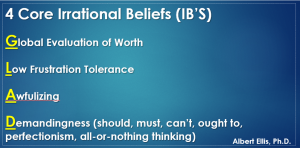
So now what? Well, we have to shift the paradigm. In Part 2 of “Cognitive Behavior Therapy – Weight Loss and Preventing Regain”, I’ve written the continuation of the story, “The DEF’s” of cognitive behavior therapy – CBT Part 2 of 2”. In Part 2 I describe how to address and solve the problem of the ABCs of CBT!
Be sure to check out my blog, “The DEF’s of Cognitive Behavior Therapy – CBT Part 2 of 2” by clicking HERE.
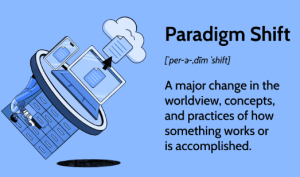
© 2024 Richard Weil All Rights Reserved